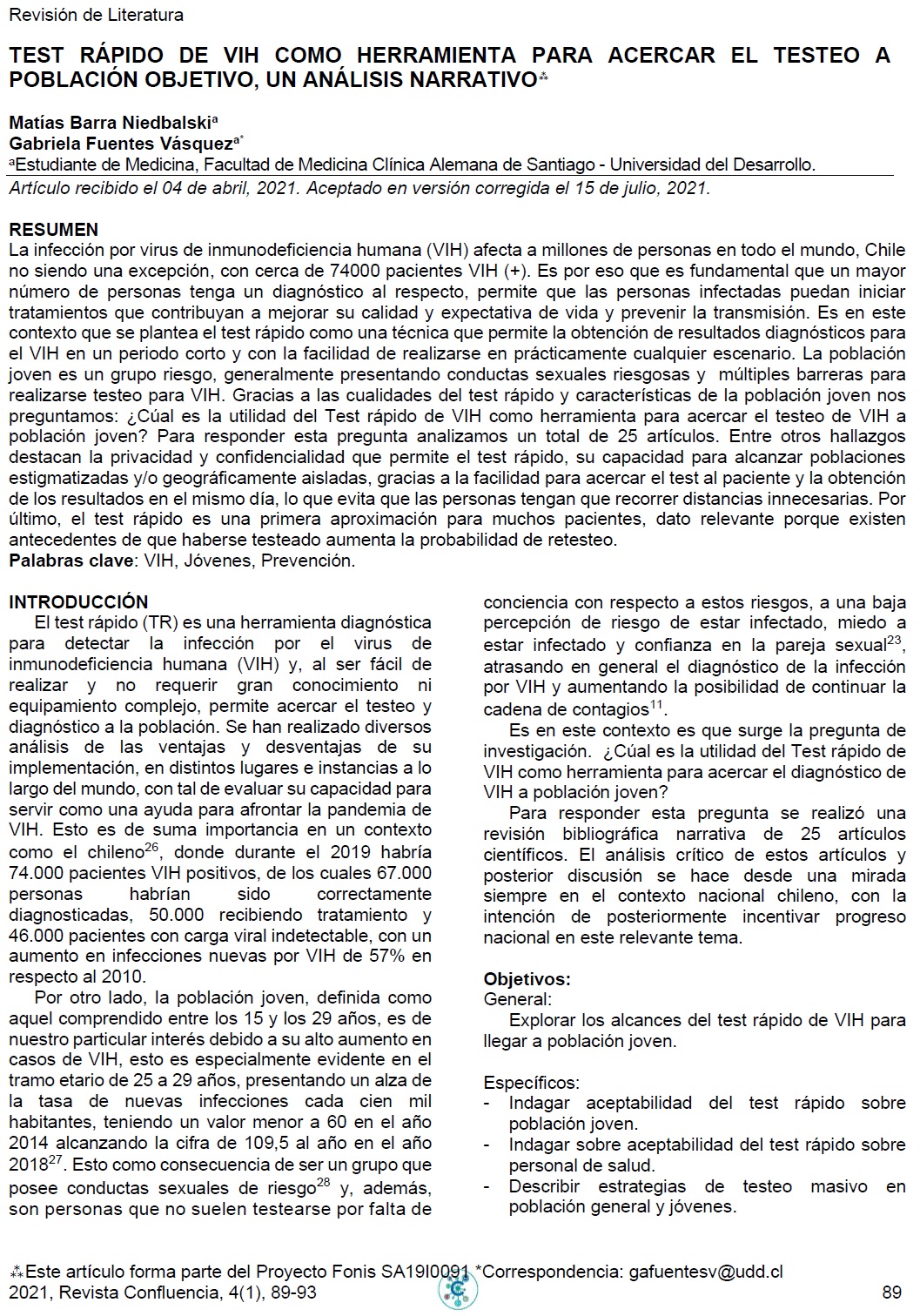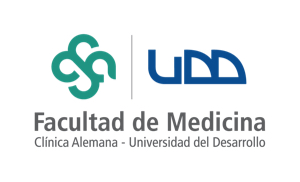Test rápido de VIH como herramienta para acercar el testeo a población objetivo, un análisis narrativo.
DOI:
https://doi.org/10.52611/confluencia.num1.2021.568Palabras clave:
VIH, Jóvenes, PrevenciónResumen
La infección por virus de inmunodeficiencia humana (VIH) afecta a millones de personas en todo el mundo, Chile no siendo una excepción, con cerca de 74000 pacientes VIH (+). Es por eso que es fundamental que un mayor número de personas tenga un diagnóstico al respecto, permite que las personas infectadas puedan iniciar tratamientos que contribuyan a mejorar su calidad y expectativa de vida y prevenir la transmisión. Es en este contexto que se plantea el test rápido como una técnica que permite la obtención de resultados diagnósticos para el VIH en un periodo corto y con la facilidad de realizarse en prácticamente cualquier escenario. La población joven es un grupo riesgo, generalmente presentando conductas sexuales riesgosas y múltiples barreras para realizarse testeo para VIH. Gracias a las cualidades del test rápido y características de la población joven nos preguntamos: ¿Cúal es la utilidad del Test rápido de VIH como herramienta para acercar el testeo de VIH a población joven? Para responder esta pregunta analizamos un total de 25 artículos. Entre otros hallazgos destacan la privacidad y confidencialidad que permite el test rápido, su capacidad para alcanzar poblaciones estigmatizadas y/o geográficamente aisladas, gracias a la facilidad para acercar el test al paciente y la obtención de los resultados en el mismo día, lo que evita que las personas tengan que recorrer distancias innecesarias. Por último, el test rápido es una primera aproximación para muchos pacientes, dato relevante porque existen antecedentes de que haberse testeado aumenta la probabilidad de retesteo.
Descargas
Citas
Chirombo B et al. Assessment of readiness to transition from antenatal HIV surveillance surveys to PMTCT programme data-based HIV surveillance in South Africa: The 2017 Antenatal Sentinel HIV Survey. International Journal of Infectious Diseases. 2020;91:50-56.
Sanders E, Chirro O, Oduor C, Mangi J, Wahome E, Price M et al. Point-of-care HIV RNA testing and immediate antiretroviral therapy initiation in young adults seeking out-patient care in Kenya. AIDS. 2019;33(5):923-926.
Mullens A, Duyker J, Brownlow C, Lemoire J, Daken K, Gow J. Point-of-care testing (POCT) for HIV/STI targeting MSM in regional Australia at community ‘beat’ locations. BMC Health Services Research. 2019;19(1).
Young N, Achieng F, Desai M, Phillips-Howard P, Hill J, Aol G et al. Integrated point-of-care testing (POCT) for HIV, syphilis, malaria and anaemia at antenatal facilities in western Kenya: a qualitative study exploring end-users’ perspectives of appropriateness, acceptability and feasibility. BMC Health Services Research. 2019;19(1).
Wang Q, Chan P, Newman L, Dou L, Wang X, Qiao Y et al. Acceptability and feasibility of dual HIV and syphilis point-of-care testing for early detection of infection among pregnant women in China: a prospective study. BMJ Open. 2018;8(10):e020717..
Armstrong H, Wang L, Zhu J, Lachowsky N, Card K, Wong J et al. HIV Testing Among a Representative Community Sample of Gay, Bisexual, and Other Men Who Have Sex with Men in Vancouver, Canada. AIDS and Behavior. 2018;23(2):347-358.24
Fan H, Fife K, Cox D, Cox A, Zimet G. Behavior and health beliefs as predictors of HIV testing among women: a prospective study of observed HIV testing. AIDS Care. 2018;30(8):1062-1069.
Johnston J, Reimer J, Wylie J, Bullard J. Observational study of the populations accessing rapid point-of-care HIV testing in Winnipeg, Manitoba, Canada, through a retrospective chart review of site records. Sexually Transmitted Infections. 2017;94(3):194-199.
Pascom A, Dutra de Barros C, Lobo T, Pasini E, Comparini R, Caldas de Mesquita F. Point-of-care HIV tests done by peers, Brazil. Bulletin of the World Health Organization. 2016;94(8):626-630.
Agboghoroma C, Ukaire B. Prevalence and risk factors of human immunodeficiency virus and hepatitis C virus infection among pregnant women attending antenatal care at a tertiary hospital in Abuja, Nigeria. Nigerian Medical Journal. 2020;61(5):245.
Signer D, Peterson S, Hsieh Y, Haider S, Saheed M, Neira P et al. Scaling up HIV Testing in an Academic Emergency Department: An Integrated Testing Model with Rapid Fourth-Generation and Point-of-Care Testing. Public Health Reports. 2016;131(1_suppl):82-89.
Reynolds G, Fisher D, Brocato J, van Otterloo L, Khahlil K, Huckabay L. Stressful point-of-care rapid testing for human immunodeficiency virus, hepatitis C virus, and syphilis. International Journal of STD & AIDS. 2016;28(10):975-984.
Ribeiro L, Sabidó M, Galbán E, Guerra J, Mabey D, Peeling R et al. Home-based counseling and testing for HIV and syphilis – an evaluation of acceptability and quality control, in remote Amazonas State, Brazil: Table 1. Sexually Transmitted Infections. 2014;91(2):94-96.
Wynberg E, Cooke G, Shroufi A, Reid S, Ford N. Impact of point-of-care CD4 testing on linkage to HIV care: a systematic review. Journal of the International AIDS Society. 2014;17(1):18809.
Burns F, Edwards S, Woods J, Haidari G, Calderon Y, Leider J et al. Acceptability, feasibility and costs of universal offer of rapid point of care testing for HIV in an acute admissions unit: results of the RAPID project. HIV Medicine. 2013;14:10-14.
Schwandt M, Nicolle E, Dunn S. Preferences for Rapid Point-of-Care HIV Testing in Primary Care. Journal of the International Association of Physicians in AIDS Care. 2012;11(3):157-163.
Lubelchek R, Kroc K, Levine D, Beavis K, Roberts R. Routine, Rapid HIV Testing of Medicine Service Admissions in the Emergency Department. Annals of Emergency Medicine. 2011;58(1):S65-S70..
MacPherson P, Chawla A, Jones K, Coffey E, Spaine V, Harrison I et al. Feasibility and acceptability of point of care HIV testing in community outreach and GUM drop-in services in the North West of England: A programmatic evaluation. BMC Public Health. 2011;11(1).
Siegel M, Kennedy L, Rexroth K, Lankford M, Turner M, McKnight A et al. Better But Not Ideal Acceptance of Routine Inpatient HIV Point-of-Care Testing Among Veterans in a High Prevalence Area. JAIDS Journal of Acquired Immune Deficiency Syndromes. 2010;55(2):205-210.
Smith P, Clayton J, Pike C, Bekker L. A review of the atomoRapid HIV self-testing device: an acceptable and easy alternative to facilitate HIV testing. Expert Review of Molecular Diagnostics. 2019;19(1):9-14.
Genberg B, Lee H, Hogan J, Some F, Wachira J, Wu X et al. Point of Diagnosis and Patient Retention in HIV Care in Western Kenya. JAIDS Journal of Acquired Immune Deficiency Syndromes. 2018;78(4):383-389.
Young N, Taegtmeyer M, Aol G, Bigogo G, Phillips-Howard P, Hill J et al. Integrated point-of-care testing (POCT) of HIV, syphilis, malaria and anaemia in antenatal clinics in western Kenya: A longitudinal implementation study. PLOS ONE. 2018;13(7):e0198784.
Morales A, Espada J, Orgiles M. Barreras hacia la prueba de detección del VIH en adolescentes en España. Pyschosocial intervention. 2016;25(3).
Chacón-Quezada T, Corrales-Gonzalez D, Garbanzo-Núñez D, Gutiérrez-Yglesias J, Hernández-Sandí A, Lobo-Araya A et al. TS Y SIDA en adolescentes: descripción, prevención y marco legal. Medicina legal Costa Rica. 2009;26(2)..
Rubiano Y, Saldarriaga J. Jóvenes y VIH/SIDA: enfoques y perspectivas en investigación. Index enfermería. 2011;20(1-2).
Country factsheets CHILE | 2019. ONUSIDA; 2021.
Plan nacional de prevención y control del VIH/SIDA e ITS 2018-2019. Ministerio de salud de Chile; 2021.
Toska E, Pantelic M, Meinck F, Keck K, Haghighat R, Cluver L. Sex in the shadow of HIV: A systematic review of prevalence, risk factors, and interventions to reduce sexual risk-taking among HIV-positive adolescents and youth in sub-Saharan Africa. PLOS ONE. 2017;12(6):e0178106

Descargas
Publicado
Cómo citar
Número
Sección
Licencia
Derechos de autor 2021 Revista Confluencia

Esta obra está bajo una licencia internacional Creative Commons Atribución-NoComercial-SinDerivadas 4.0.








